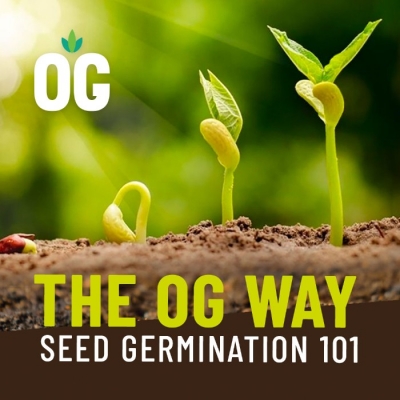Growing marijuana is hard but, ultimately, very rewarding work. In South Africa, we’re faced with a truly novel cannabis cultivation dilemma, especially indoors, thanks to Eskom. Growers take pride in every step of the process, from seed or clone to final harvest, and face many often-unforeseen obstacles along the way. But is load shedding the biggest pest of them all? And what can you do about it? Let’s find out.
IN THIS ARTICLE:
Proudly South African Problem
Load Shedding During Veg
Load Shedding During Flower
OG’s Simple Solution
The Load Shedding Problem
Indoor growing is the fine dining of cannabis cultivation. It’s artwork. And most growers take great pride in meticulously caring for their plants day in, day out. Each unwanted leaf surgically removed. Nutrients carefully calculated to the millilitre. Every water drop strategically aimed at reaching roots top to bottom.
So, when it comes to things that are outside of our control that can compromise the quality and value of our precious jewels, one word fits best… panic!

Mildew and fungi, mites and bugs – we have some control over these, preventatively and retroactively. But there’s one demon lurking in the darkness (pardon the pun) that’s at the forefront of the minds of South African cannabis growers that doesn’t get the full attention it deserves… and it’s probably the biggest pest of them all… LOAD SHEDDING!
There’s a saying that rings true anywhere in the world: “You can’t control the weather.” Now, indoor growers will be thinking, “Wait a minute, yes we literally can and do! Daylight, temperature, humidity, wind and rain, we control it all.” Well, Eskom tend to disagree. We can’t control our electricity supply in SA, so the message remains the same. Focus on the things that are within our control. Which leads to the obvious question: What can we do about load shedding?
Outdoor growers? Worry not. Fortunately for the survival of our species, Eskom does not control the sunlight. Though you’ll need back-up plans for pumps and whatever else not working come watering time. Indoor cultivators, however, have a much greater cause for concern. You see, marijuana plants are very sensitive to changes in their light cycle.
Fact 1: Cannabis plants shift genetically – via the activation of floral meristem identity genes – from a vegetative state into flowering due to changes in length of daylight hours, temperature, and hormones.
Fact 2: Environmental stressors can stress female marijuana plants into becoming hermaphrodites, leading to pollination and seed production.
These facts won’t be filling you with confidence or helping you to feel at ease. It always seems as though, just when we forget about the severe strain (no pun intended) that our power grid is under, Eskom make an announcement and implement these ungodly rolling blackouts.
Load Shedding During Veg
Interruptions in the light cycle are stressful for your marijuana plants. If these light changes are excessive to the point where your plants are shocked into constant, rapid shifts between day and night cycles, this could lead to hermaphroditism. In other words, your female plants (grown from feminized seeds) will develop into mixed-gender plants, which will start to display both male and female reproductive organs during pre-flowering.
Our article How to Grow Regular Seeds explains more about marijuana sexes and, importantly, how to identify male or hermie plants by their pollen sacs, which then need to be carefully removed and killed off right after flipping to flowering.
Another frightening but very realistic prospect is that your plants will switch over to the dark side…that is, the flowering phase, sooner than you intended. This is obviously far from ideal for many reasons. Good thing we have a simple solution.
Load Shedding During Flowering
The good news is that load shedding during the flowering phase is unlikely to have a direct major detrimental impact on your precious plants. Granted, the state of the electricity grid could worsen at any moment and Eskom could prove us wrong by implementing an absurd amount or stage of load shedding. But chances are this will only stand to stifle the growth of your plants and their flowers. At worst, a lack of light and ventilation at the wrong time of year could provide the optimum conditions for something like powdery mildew to take hold – look out for the signs.
Now, we’ve spoken about the impact of too much darkness. But as it turns out, the real concern during this growth phase is hiding in plain sight – light poisoning. Light leaks or accidentally leaving load shedding lights on during your plants’ restorative night-time hours is, in fact, one of the most common triggers of stress and can cause seedy flowers. All it takes is one stressed plant to turn into a hermaphrodite and go undetected by your watchful eyes, leading to self- and cross-pollination, and turning your precious flower harvest into a seedy one.
OG’s Simple Load Shedding Solution
Own your grow and stick to the plan. In veg, 18 hours of light, coupled with 6 hours of darkness. During flowering, stick to a 12/12 light/dark cycle. Regardless of growth phase, don’t be tempted to add or subtract an hour here and there. The simplest thing to do is stick to the plan and supplement with other lighting sources. “Wait a minute, do you want me to wake up at 2AM and light a candle or buy a R20,000 backup generator?” Fortunately, no.
Generators (and the petrol that fuels them) and UPSs (uninterrupted power supply systems) are expensive and impractical for the needs of most hobby growers. So, without upgrading your entire setup at significant cost, the best thing we can do is damage limitation. And now for the good news… there’s a simple, cost-effective “fix”.
Essentially, you want to give your plants light, first and foremost (they’ll survive without ventilation for longer than 2 hours). Nothing is going to fuel your photosynthesizing plants quite as much as the hundreds to thousands of Watts bulbs designed to imitate powerful natural sunlight. At the very least though, you want to help your plants avoid stress by distinguishing between day and night. As a last resort, you can always set your alarm, get up at an inhumane hour, and direct the flashlight from your phone toward your plants (assuming the battery will last).

But a simple, battery-operated light bought from a store for just a few hundred Rand can make the world of difference. It’s pretty safe to call it a “load shedding light” nowadays. Specifically, you want one that allows you to plug it in when you go to bed at night, which will either turn on or stay on during load shedding hours (yes, you should be running your daylight cycle at night). We managed to find one with a setting that allows it to charge up to full capacity when plugged in, while remaining off until the power goes out…and then switching on! Almost as if some legend / genius had our exact problematic situation in mind.
Remember: light pollution causes hermaphroditism and seedy buds. Yes, you want your light to switch on when the power goes out during your light cycle. But it’s equally essential to manually change your light’s setting to off and unplug it afterwards, in order to prevent light leakage during load shedding in dark hours.
So, there you have it. To avoid crawling out of bed at 2AM and hovering over your plants with your cellphone’s flashlight for 2 hours, a load shedding light (or better still, two) is all you need – and a bit of cognisance to ensure you switch lights off so there’s no light pollution.
If you are unfortunate enough to suffer from “seeded flower syndrome”, there’s a consolation prize. The good news is that your new seeds are likely to be feminized, that is, if they came from hermaphroditic females. You can reuse them in a kind of natural recycling process. Naturally pollinated regular seeds, however, have a 50/50 likelihood of germinating into males or females. But that’s a story for another day.
We can’t help but wonder what sort of impact legalization will have on our already over-strained (pun kind of intended) electricity grid. The environmental impact of large-scale indoor cannabis cultivation in a future legal climate is probably best saved for another day too.
For now, you’ll have to settle for crafting Overgrow’s elite international genetics from the comfort of your own home. What are you waiting for? Shop for cannabis seeds.




